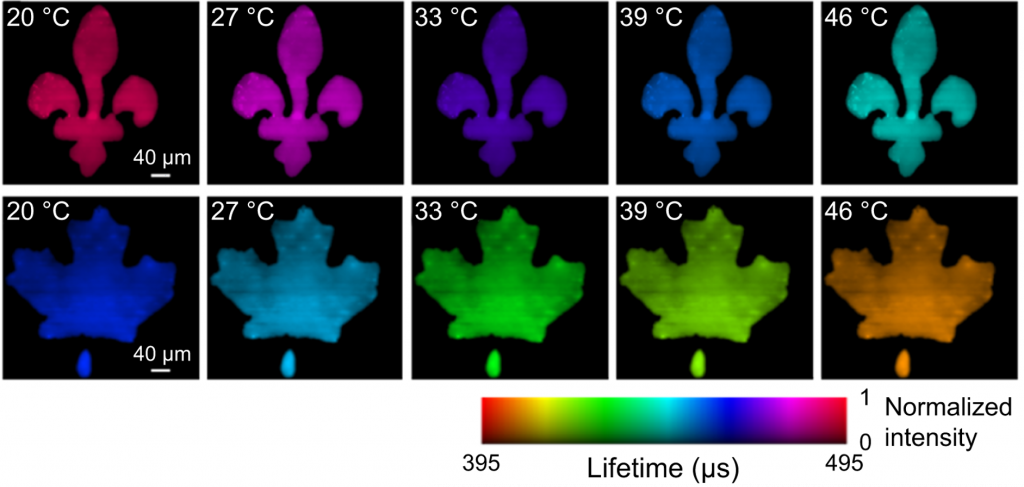A new imaging method, formulated by the teams of Professors Jinyang Liang and Fiorenzo Vetrone at the Institut National de la Recherche Scientifique (INRS), can compute temperature in 2D, without contact, and within a snap.
 Lifetime images of green (top row) and red (bottom row) upconversion emission bands under different temperatures captured by SPLIT. (Image Credit: Jinyang Liang).
Lifetime images of green (top row) and red (bottom row) upconversion emission bands under different temperatures captured by SPLIT. (Image Credit: Jinyang Liang).
The results of their study have been published in the journal Nature Communications. This exact real-time temperature detection could soon enhance photothermal therapy and help in the diagnosis of skin cancers at the early stage.
This technology, called single-shot photoluminescence lifetime imaging thermometry (SPLIT), is formulated on the luminescence of nanoparticles doped with rare earth ions.
These nanoparticles are considered as nanothermometers because their luminescent properties change with the temperature of the environment. They are also biocompatible.
Fiorenzo Vetrone, Professor, Institut National de la Recherche Scientifique
Vetrone is a pioneer in this field of study.
Rather than imaging the luminescence point by point, which is laborious, SPLIT uses a unique ultrahigh-speed camera to monitor how rapidly the luminescence degenerates of these nanoparticles in every spatial point.
Our camera is different from a common one, where each click gives one image: our camera works by capturing all the images of a dynamic event into one snapshot. Then we reconstruct them, one by one.
Xianglei Liu, Study Lead Author and PhD student, Institut National de la Recherche Scientifique
The temperature can then be detected by inspecting how rapidly the emitted light fades out. As it is in real-time, SPLIT can track the occurrence as it transpires. For the first time, it allows luminescence thermometry using the lifetime of a nanoparticle with a moving sample.
Compared to existing thermometry techniques, SPLIT is faster and has higher resolution. This allows a more accurate temperature sensing with both an advanced and economical solution.
Jinyang Liang, Professor, Institut National de la Recherche Scientifique
Liang is an expert in ultrafast imaging.
Health Applications
Professors Liang and Vetrone trust that SPLIT technology could, besides other things, improve the ability to sense and treat skin cancers. At the moment, the capacity to sense melanomas, and more precisely micro-melanomas, is still inadequate. Current diagnostic approaches are limited by their resolution, invasiveness and accuracy, which results in a large number of needless biopsies.
Optical thermometry could therefore be employed to sense cancer cells, whose fast metabolism results in a higher temperature than that of usual tissue, rendering them more visible with SPLIT.
To identify melanoma, clinics can employ a thermal camera, but the resolution is poor.
SPLIT marks an important step in the technical development. With high resolution, the technology could be used to precisely locate the cancerous mole.
Jinyang Liang, Professor, Institut national de la recherche scientifique
Besides detection, this technology could also be employed to track the light dose during specific types of treatment. For example, photothermal therapy destroys cancer cells via the heat produced by exposure to near-infrared light.
“We want to eradicate the cancer, but not the surrounding tissue, so if the temperature is too high, the treatment could be decreased or stopped for a while. If it’s too low, we can increase the light to get the right dose,” says Vetrone.
In 2020, the Canadian Cancer Society projected that 8,000 Canadians had been diagnosed with just this type of cancer.
Journal Reference:
Liu, X., et al. (2021) Fast wide-field upconversion luminescence lifetime thermometry enabled by single-shot compressed ultrahigh-speed imaging. Nature Communications. doi.org/10.1038/s41467-021-26701-1.